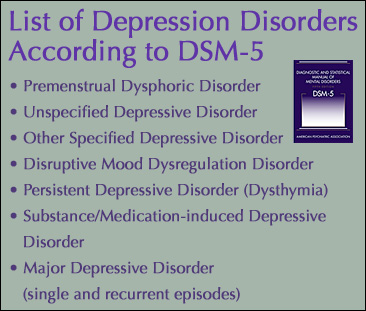
Find information about an MDD treatment for your patients. For MDD treatment options. How to diagnose major depressive disorder? What is treatment for mild depression?
What are the DSM mood disorders? Persistent depressive disorder , also called dysthymia (dis-THIE-me-uh), is a continuous long-term (chronic) form of depression. You may lose interest in normal daily activities, feel hopeless, lack productivity, and have low self-esteem and an overall feeling of inadequacy. A person diagnosed with persistent depressive disorder may have episodes of major depression along with periods of less severe symptoms , but symptoms must last for two years to be considered persistent depressive disorder. Depression is a mood disorder that causes a persistent feeling of sadness and loss of interest.
Also called major depressive disorder or clinical depression, it affects how you feel, think and behave and can lead to a variety of emotional and physical problems. Learn about its symptoms , causes, treatment, and more. It is generally experienced as a less severe but more. With dysthymia, the depression symptoms can linger for a long period of.
It’s also called persistent depressive disorder. Dysthymia is a milder, but long-lasting form of depression. People with this condition may also have bouts of major depression at times. It affects the way you eat and sleep, think about things, and feel about yourself.
This term is used to describe two conditions. While someone with major depressive disorder will typically “cycle” through episodes of feeling severely depressed and then be symptom-free for periods of time, dysthymia presents with persistent symptoms for years. Find treatment resources as well as safety and clinical data pertinent to doctors.

Note: Because the criteria for major depressive episode include four symptoms that are absent from the symptom list for persistent depressive disorder (dysthymia), a very limited number of individuals will have depressive symptoms that have persisted longer than two years but will not meet criteria for persistent depressive disorder. Major depressive disorder is a mood disorder that interferes with daily life. If full criteria for a major depressive episode have been met at some point during the current episode of illness, they should be given a diagnosis of major depressive disorder. It is consistently struggling with depressive symptoms.
While the symptoms may ebb and flow, they are never gone for longer than months. The symptoms are milder than major depressive disorder but additional symptoms involved in MDD may develop during dysthymia and lead to a diagnosis of MDD. The depressed state of persistent depressive disorder is not as severe as with major depression, but can be just as disabling.

A diagnosis of persistent depressive disorder requires having experienced a combination of depressive symptoms for two years or more. Part of the problem is that most people don’t even realize they have it. While not as serious or disabling as other forms of clinical depression, persistent depressive disorder (PDD) is a more chronic form of persistent depression. It is characterized by a depressed mood or loss of interest or pleasure in almost all activities most of the time for at least two years.
The symptoms of persistent depressive disorder are similar to those of major depression. In this disorder , the long duration is the key to the diagnosis, not the intensity of symptoms. As with major depression, mood may be either low or irritable. An individual with persistent depressive disorder may feel less pleasure and a lack of energy. Dysthymic disorder , or persistent depressive disorder , also called dysthymia, involves symptoms of sad or down mood most days for most of the day over a long term (two years or longer) but the.

This disorder has been poorly understoo and its classification has evolved due to the complicated and ever-evolving nature of the nosology of depressive disorders. In the past, this disease was considered a depressed personality state, but it. The latest edition of the Diagnostic and Statistical Manual of Mental Disorders (DSM-5) consolidated dysthymia and chronic major depressive disorder under the umbrella of persistent depressive disorder , which includes any chronic depression running on a. Persistent Depressive Disorder is a more chronic and sometimes less intense version of MDD.
No comments:
Post a Comment
Note: Only a member of this blog may post a comment.